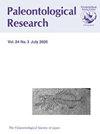Late Cretaceous Diatoms (Bacillariophyta) from the Teshio-Nakagawa Area, Hokkaido, Northern Japan: Significance for Their Origin and Biostratigraphy
IF 0.6
4区 地球科学
Q3 PALEONTOLOGY
引用次数: 0
Abstract
Abstract. Well-preserved marine diatoms are documented for the first time from authigenic carbonate rocks induced by cold methane (hydrocarbon) seepage in the Omagari Formation (latest Santonian to earliest Campanian in age, Late Cretaceous Epoch; around 83.6 Ma) of the upper part of the Yezo Group in the Teshio-Nakagawa area, northern Hokkaido (northern Japan). The diatom flora is rich in species of Hemiaulus and Triceratium, associated with a few other extinct diatom genera. An araphid genus (Sceptroneis) was also observed; this is one of the earliest fossil records of “pennate” (Bacillariophyceae) diatoms. Although valve ultrastructures have been mostly dissolved, the preservation of these diatoms is much better than that in the few previous reports of Cretaceous siliceous photosynthetic organisms from Japan and adjacent regions in the northwestern Pacific Ocean. Because of their common generic composition in the mid- to high-latitude regions in both hemispheres, diatoms are suggested to have experienced a global radiation by early Campanian time. Thus, our diatom records provide insights into the Late Cretaceous floral adaptive radiation around the northwestern Pacific margin, where the radiation history of diatoms is yet unclear. As Gladius antiquus was confirmed but Basilicostephanus species were absent from the present material, the flora from the Teshio-Nakagawa area is tentatively regarded as belonging to the G. antiquus Concurrent Range Zone, an interval extending from an undetermined Late Cretaceous Epoch to the latest Santonian Age. However, this floral correlation is inaccurate because our materials are latest Santonian to earliest Campanian in age, as dated by the molluscan (ammonoids and inoceramids) biostratigraphy. Hence, further research is required to clarify the sensitivity of different chronological proxies and the stratigraphic ranges of age-diagnostic diatoms in different geographic provinces.日本北部北海道中川特秀地区晚白垩世硅藻(硅藻门)的起源和生物地层学意义
摘要北海道北部(日本北部)Teshio-Nakagawa地区Yezo群上部的Omagari组(年龄最晚的Santonian至最早的Campanian,白垩纪晚期;约83.6 Ma)中,首次记录到由冷甲烷(碳氢化合物)渗流引起的自生碳酸盐岩中保存完好的海洋硅藻。硅藻区系中有丰富的半壳藻属和三角藻属,与其他几个已灭绝的硅藻属有关联。还观察到了一个araphid属(Sceptroneis);这是最早的硅藻化石记录之一。尽管阀瓣的超微结构大多已溶解,但这些硅藻的保存情况比之前为数不多的来自日本和西北太平洋邻近地区的白垩纪硅质光合生物的报告要好得多。由于硅藻在两个半球的中高纬度地区有着共同的一般组成,人们认为硅藻在坎帕尼亚时代早期就经历了全球辐射。因此,我们的硅藻记录为西北太平洋边缘晚白垩世植物适应性辐射提供了见解,那里的硅藻辐射历史尚不清楚。由于Gladius antiquus已被证实,但Basilicostephanus物种不在目前的材料中,Teshio Nakagawa地区的植物群暂时被认为属于G.antiquus并发山脉带,该区间从未确定的晚白垩世延伸到最新的Santonian时代。然而,这种花的相关性是不准确的,因为我们的材料的年龄是最晚的桑托阶到最早的坎潘阶,根据软体动物(菊石和无神经酰胺)的生物地层学确定。因此,需要进一步研究,以阐明不同地理省份不同年代指标的敏感性和年龄诊断硅藻的地层范围。
本文章由计算机程序翻译,如有差异,请以英文原文为准。
求助全文
约1分钟内获得全文
求助全文
来源期刊

Paleontological Research
PALEONTOLOGY-
CiteScore
1.60
自引率
0.00%
发文量
47
审稿时长
>12 weeks
期刊介绍:
Paleonotological Research (PR) is a quarterly, peer-reviewed international journal, which focuses on original contributions primarily in the area of paleontology but also covering a wide range of allied sciences. It has been published since 1997 as a successor to the former journal Transactions and Proceedings of the Palaeontological Society of Japan. The emphasis of contributions will include global and local perspectives, and contents can cover all ages (Precambrian to the Quaternary, including the present time).
 求助内容:
求助内容: 应助结果提醒方式:
应助结果提醒方式:


